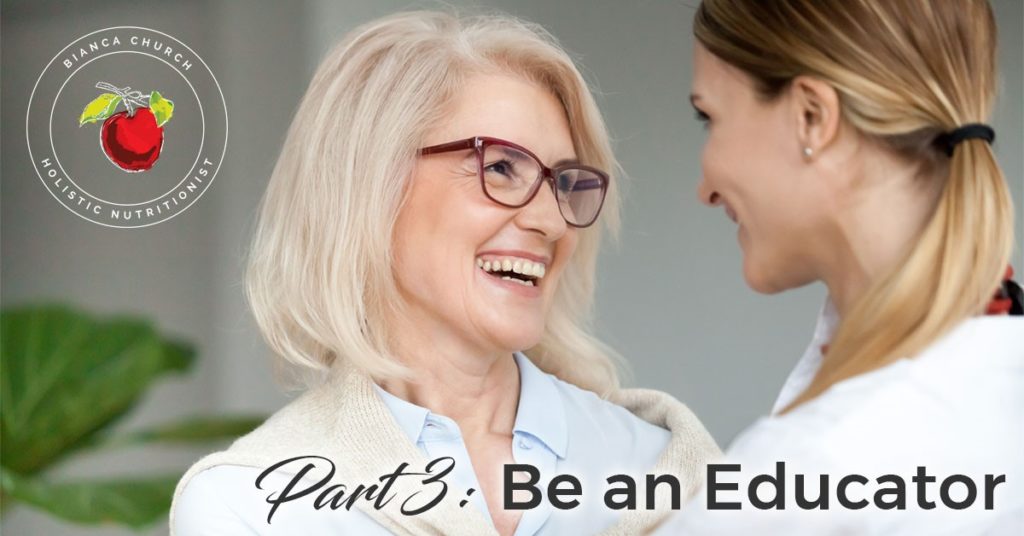Holistic Nutritionist – As Catalyst for Change Part III – “Be an Educator”

In my last column, I discussed that the holistic health practitioner is as a catalyst for change and that to be this catalyst they must be prepared to adopt three principles:
1) To embrace a holistic and progressive model of health that emphasizes accountability and self-responsibility
2) To be an educator
3) To lead by example
This column will explore the second principle: “Be an Educator”
If you are to be a catalyst for change then your focus must be to share your knowledge and be first and foremost an educator and teacher. I do not believe that focusing on treating or healing disease will facilitate change towards encouraging accountability and self-responsibility, but I do believe in giving people the skills and knowledge to create their own wellness and that recognizing one’s own role in their illnesses will facilitate wellness.
This means your role as an educator will be to help your clients become informed, empowered and self-responsible individuals and to facilitate this change, all you need to do is to keep things simple, be patient, and be supportive.
Simple means that you will:
- Present only the knowledge specific to that individual.
- That you will explain that knowledge in a language your client will understand.
- You will provide materials that are concise, easy to read, and not overwhelming.
- You will be patient with their learning curve.
- You will be non-judgmental of their progress.
- You will provide a record of your work so that they can refer to it in the future.
Patient means that you will:
- Have no expectations because wellness is not a project with a start and end date, it is a lifelong process that is ever changing.
- Patient also mean that just because you teach someone something today doesn’t mean they have to do it tomorrow. They may choose to hold on to that piece of knowledge and incorporate it later when they are ready.
Supportive means that you will:
- Be there to walk beside them in their journey.
- Understand their challenges.
- Be flexible as needed to facilitate their changes.
- Know when to let go.
Once you have educated your client, the rest is up to them. They will have to create their own wellness with the knowledge you have provided them. However, remember that facilitating self-responsible and accountable individuals also depends on you, the practitioner, being able to let go. To truly understand your role is to fully embrace the fact that your goal is to create a client who doesn’t need you anymore. Just as the mother bird pushes her young out of the nest and trusts that they will fly, so must you expect your clients to stand on their own. Don’t be afraid of this. There are millions of people out there who will need your knowledge and services.
“There will always be enough”
Clients will come to you from all walks of life and many will want to hang on to you but if you allow this, you are not facilitating change, you are creating dependency. This concept can be unsettling for both the practitioner and the client. The practitioner must believe that there will always be people who need their services and the client must believe that they can create their own wellness.
It is a very intimate relationship between teacher and student and requires a level of trust that must be cultivated by you, the practitioner.
I experienced this with my own mentor who visited with me in Ontario from British Columbia. She was in my office and I was proudly showing her my new books, “Wellness Business Systems” and was telling her of my work with students and graduates. She looked around my office and looked at me and said, “Bianca, you do not need me anymore.” And then quietly stood there in front of my desk, lovingly looking at me, while I experienced that initial panic one feels when their parent lets go of the back of their bike and the training wheels have just been taken off. She was letting me go to make my own way and, in that moment, she created an empowered individual in me.
As must you do with your clients if you are to be a catalyst for change. Let them go, let them make their choice for wellness and be their own creator of their future.
But there is one last principle that is necessary to finish this series and that is to lead by example and in my next column I will elaborate on this concept and then close this series with a summary.
